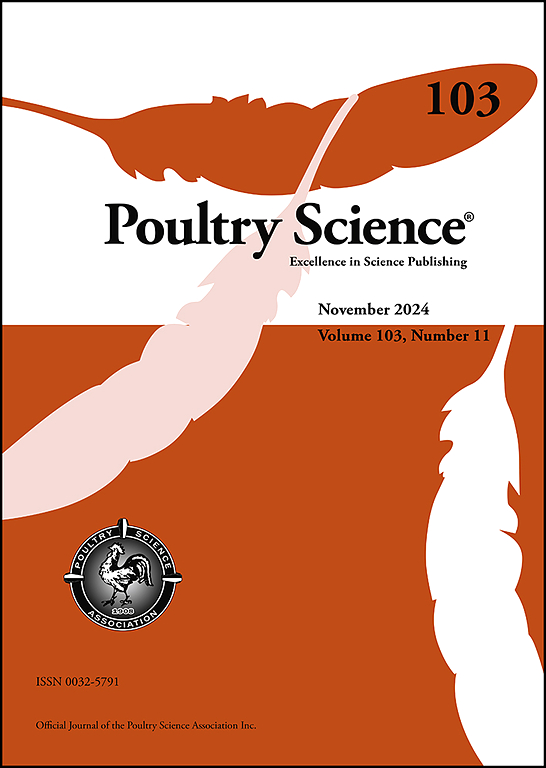综述:家禽孵蛋行为及其分子机制的研究进展
IF 4.2
1区 农林科学
Q1 AGRICULTURE, DAIRY & ANIMAL SCIENCE
引用次数: 0
摘要
孵蛋是雌性家禽表现出的一种自然的母性行为,其特征是坐在巢上的时间增加,羽毛蓬松,食欲下降,停止产卵和孵化行为。母禽的产蛋特性主要受外部环境因素和内部因素(如遗传和激素)的调控,并在器官、细胞和分子水平上进行调控。在器官水平上,下丘脑-垂体-卵巢(HPO)轴在调节产卵行为中起着至关重要的作用。在细胞水平上,下丘脑激素(如GnRH)、垂体激素(如PRL、FSH、LH)和性腺激素(如雌激素、孕激素)与细胞膜上相应的受体结合,激活不同的信号通路,调节颗粒细胞(GCs)的凋亡和自噬,从而影响产卵行为的发生。在分子水平上,鸟类的育性行为是一种由多基因控制的复杂性状,表观遗传学在基因表达调控中起着关键作用。然而,这些因素如何影响卵巢结构和功能,从而导致排卵行为的确切调节机制尚不清楚。因此,本文从禽类孵蛋行为的特点、孵蛋前后生殖系统的形态变化等方面进行了探讨,并从器官、细胞和分子水平对其调控机制进行了综述,旨在为禽类孵蛋的进一步研究提供参考。本文章由计算机程序翻译,如有差异,请以英文原文为准。
Review: Research progress on broodiness behavior and its molecular mechanisms in poultry
Broodiness is a natural maternal behavior exhibited by female poultry, characterized by increased time spent sitting on the nest, feather fluffing, decreased appetite, cessation of egg-laying, and incubation behavior. The broodiness characteristics of female poultry are primarily regulated by external environmental factors and internal factors (such as genetics and hormones), and are regulated at the organ, cell, and molecular levels. At the organ level, the hypothalamic-pituitary-ovarian (HPO) axis plays a crucial role in regulating broodiness behavior. At the cellular level, hypothalamic hormones (such as GnRH), pituitary hormones (such as PRL, FSH, and LH), and gonadal hormones (such as estrogen and progesterone) bind to corresponding receptors on the cell membrane, activating different signaling pathways to regulate the apoptosis and autophagy of granulosa cells (GCs), thereby influencing the occurrence of broodiness behavior. At the molecular level, broodiness behavior in avian species is a complex trait controlled by multiple genes, with epigenetics playing a key role in the regulation of gene expression. However, the exact regulatory mechanisms of how these factors affect the ovarian structure and function, and consequently lead to broodiness behavior, remain unclear. Therefore, this paper discussed the characteristics of poultry broodiness behavior, the morphological changes in the reproductive system before and after broodiness, and provided a review of the regulatory mechanisms at the organ, cellular, and molecular levels, aiming to provide a reference for future research on poultry broodiness.
求助全文
通过发布文献求助,成功后即可免费获取论文全文。
去求助
来源期刊

Poultry Science
农林科学-奶制品与动物科学
CiteScore
7.60
自引率
15.90%
发文量
0
审稿时长
94 days
期刊介绍:
First self-published in 1921, Poultry Science is an internationally renowned monthly journal, known as the authoritative source for a broad range of poultry information and high-caliber research. The journal plays a pivotal role in the dissemination of preeminent poultry-related knowledge across all disciplines. As of January 2020, Poultry Science will become an Open Access journal with no subscription charges, meaning authors who publish here can make their research immediately, permanently, and freely accessible worldwide while retaining copyright to their work. Papers submitted for publication after October 1, 2019 will be published as Open Access papers.
An international journal, Poultry Science publishes original papers, research notes, symposium papers, and reviews of basic science as applied to poultry. This authoritative source of poultry information is consistently ranked by ISI Impact Factor as one of the top 10 agriculture, dairy and animal science journals to deliver high-caliber research. Currently it is the highest-ranked (by Impact Factor and Eigenfactor) journal dedicated to publishing poultry research. Subject areas include breeding, genetics, education, production, management, environment, health, behavior, welfare, immunology, molecular biology, metabolism, nutrition, physiology, reproduction, processing, and products.
 求助内容:
求助内容: 应助结果提醒方式:
应助结果提醒方式:


